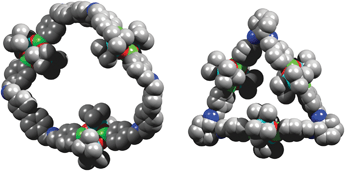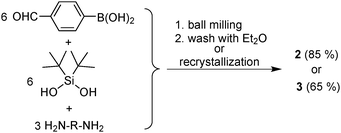Synthesis of borasiloxane-based macrocycles by multicomponent condensation reactions in solution or in a ball mill†‡
Mirela
Pascu
,
Albert
Ruggi
,
Rosario
Scopelliti
and
Kay
Severin
*
Institut des Sciences et Ingénierie Chimiques, École Polytechnique Fédérale de Lausanne (EPFL), Lausanne, Switzerland. E-mail: kay.severin@epfl.ch; Fax: +41 (0)21 6939305; Tel: +41 (0)21 6939302
First published on 19th November 2012
Abstract
Large macrocycles containing imine and borasiloxane links are obtained in polycondensation reactions of 4-formylbenzeneboronic acid, t-Bu2Si(OH)2, and diamines. The multicomponent reactions can be performed in solution or – advantageously – by mechanochemical syntheses in a ball mill.
Condensation reaction of polyamines with polyaldehydes can be used to construct molecularly defined nanostructures1 and covalent organic frameworks.2 Imine links are highly successful in this context because they are dynamic covalent bonds,3 which allow error correction processes to occur during the synthesis. We and others have shown that imines can be used in combination with boronic acid–diol condensations.4,5 The parallel utilization of imines and boronate esters permits the construction of complex nanostructures such as macrocycles or cages in multicomponent reactions from simple building blocks. In extension of this work, we have explored whether imines could be combined with other types of condensation reactions. The condensation of silane diols with boronic acids appeared to be a potentially suited coupling reaction. This reaction is known to give cyclic borasiloxanes of the general formula (R2SiO)2(R′BO)2.6 Diboratetrasiloxanes have been employed in polymer chemistry,7 but their utilization in structural supramolecular chemistry is mostly unexplored.8 Below we show that large organic macrocycles with borasiloxane and imine linkages are indeed accessible in simple polycondensation reactions. We also demonstrate that the macrocycles are best made by mechanochemical syntheses in a ball mill.
To test the compatibility of diboratetrasiloxanes with imine condensations, we have synthesized dialdehyde 1 in 65% yield by reacting t-Bu2Si(OH)2 with 4-formylbenzeneboronic acid in toluene (Scheme 1). Borasiloxane 1 was characterized spectroscopically as well as by single crystal X-ray diffraction (see ESI‡). The eight-membered (SiOBO)4 ring of crystalline 1 is nearly flat with the coplanar 4-formylbenzene rings pointing in opposite directions. The bond lengths and angles of 1 are similar to what has been observed for (t-Bu2SiO)2(p-BrC6H4BO)29 and (t-Bu2SiO)2(PhBO)2.10
 | ||
| Scheme 1 Step-wise and one-pot synthesis of macrocycles 2 and 3. | ||
Subsequently, the dialdehyde 1 was combined with the diamines 4,4′-bis(aminomethyl)biphenyl and (1R,2R)-1,2-diaminocyclohexane. The latter diamine was chosen because it has been used previously with good success for the synthesis of imine macrocycles (‘trianglimines’).1,11 The diamine with the biphenyl spacer, on the other hand, was expected to result in an expanded structure. Condensation of 1 with the diamines in organic solvents gave macrocycles 2 and 3 in moderate yields (2:33%; 3:50%). The products were characterized by NMR spectroscopy (1H, 13C, 29Si), elemental analysis, and mass spectrometry (see ESI‡). Attempts to obtain single crystals for crystallographic analysis were unfortunately not successful. In order to estimate the size of 2 and 3, we have performed molecular modeling using the crystallographic data of 1 for calibration (see ESI‡). The 81-membered macrocycle 2 displays a diameter (max. C⋯C distance) of approximately 2.4 nm, and the 57-membered macrocycle 3 of around 1.5 nm (Fig. 1).
 | ||
| Fig. 1 The structures of macrocycles 2 (left) and 3 (right) as determined by molecular modeling. Color coding: C: grey; N: blue, O: red; B: green; Si: cyan. Hydrogen atoms are not shown. | ||
Next, we have examined whether it is possible to obtain macrocycle 2 in a one-pot reaction from t-Bu2Si(OH)2, 4-formylbenzeneboronic acid and 4,4′-bis(aminomethyl) biphenyl. This three-component reaction indeed gave the desired product, albeit in low isolated yield (20%). The 1H NMR spectrum of the crude product showed that macrocycle 2 had formed as the major product, but the recrystallization procedure employed for purification resulted in significant loss of material.
The mechanochemical synthesis of compounds by grinding solids in a mortar or – advantageously – in a ball mill is rapidly gaining popularity.12 We have recently shown that nanometer-sized cages with imine and boronate ester linkages can be obtained by polycondensation reactions in a ball mill.5b,13 These results prompted us to explore whether macrocycle 2 could also be obtained by ball-milling. The reaction was performed using a MM200 Retsch mill operating at 30 Hz. Ball milling of the boronic acid, the silane diol and the diamine for 2 × 45 min gave a white powder. 1H NMR spectroscopic analysis of this powder revealed that macrocycle 2 had formed in high yield (>90%; see ESI‡). Washing with dry diethyl ether gave pure 2 in an isolated yield of 85% (Scheme 2). Macrocycle 3 could be prepared in a similar fashion. The crude product was less pure (see ESI‡), but a simple recrystallization gave 3 in 65% yield. These results are evidence that borasiloxanes are accessible by ball-milling. Furthermore, they show that the mechanochemical syntheses of borasiloxane macrocycles can be achieved with high yields, outperforming more classical solution-based methods.
 | ||
| Scheme 2 Synthesis of macrocycles 2 and 3 by mechanochemistry. | ||
In summary, we have described the synthesis of large macrocycles with imine and borasiloxane linkages. The macrocycles are obtained in simple multicomponent condensation reactions of t-Bu2Si(OH)2, 4-formylbenzeneboronic acid, and diamines. It is conceivable that related reactions with polyfunctional building blocks (e.g. triamines) can be used to generate borasiloxane-based cages or networks. Our work is also further evidence for the utility of mechanochemistry in structural supramolecular chemistry.14
This work was supported by a Marie-Curie fellowship (M.P. IEF-2009-252716), by the Swiss National Science Foundation and by the EPFL.
Notes and references
- (a) M. E. Belowich and J. F. Stoddart, Chem. Soc. Rev., 2012, 41, 2003 RSC; (b) N. M. Rue, J. Sun and R. Warmuth, Isr. J. Chem., 2011, 51, 743 CrossRef CAS; (c) M. Mastalerz, Angew. Chem., Int. Ed., 2010, 49, 5042 CrossRef CAS; (d) N. B. Borisova, M. D. Reshetova and Y. A. Ustynyuk, Chem. Soc. Rev., 2007, 107, 46 CAS; (e) P. A. Vigato, S. Tamburini and L. Bertolo, Coord. Chem. Rev., 2007, 251, 1311 CrossRef CAS; (f) M. J. MacLachlan, Pure Appl. Chem., 2006, 78, 873 CrossRef CAS.
- (a) S.-Y. Ding and W. Wang, Chem. Soc. Rev., 2012 10.1039/c2cs35072f; (b) X. Feng, X. Ding and D. Jiang, Chem. Soc. Rev., 2012, 41, 6010 RSC.
- (a) E. Moulin, G. Cormos and N. Giuseppone, Chem. Soc. Rev., 2012, 41, 1031 RSC; (b) P. T. Corbett, J. Leclaire, L. Vial, K. R. West, J.-L. Wietor, J. K. M. Sanders and S. Otto, Chem. Rev., 2006, 106, 3562–3711 Search PubMed; (c) S. J. Rowan, S. J. Cantrill, G. R. L. Cousins, J. K. M. Sanders and J. F. Stoddart, Angew. Chem., Int. Ed., 2002, 41, 898 CrossRef.
- (a) R. Nishiyabu, Y. Kubo, T. D. James and J. S. Fossey, Chem. Commun., 2010, 46, 1124 RSC; (b) K. Severin, Dalton Trans., 2009, 5254–5264 RSC; (c) N. Fujita, S. Shinkai and T. D. James, Chem.–Asian J., 2008, 3, 1076 CrossRef CAS; (d) H. Höpfl, Struct. Bonding, 2002, 103, 1 CrossRef.
- (a) B. Icli, E. Solari, B. Kilbas, R. Scopelliti and K. Severin, Chem.–Eur. J., 2012, 18, 14867–14874 CrossRef CAS; (b) B. Icli, N. Christinat, J. Tönnemann, C. Schüttler, R. Scopelliti and K. Severin, J. Am. Chem. Soc., 2009, 131, 3154 CrossRef CAS; (c) N. Christinat, R. Scopelliti and K. Severin, Angew. Chem., Int. Ed., 2008, 47, 1848 CrossRef CAS; (d) M. Hutin, G. Bernardinelli and J. R. Nitschke, Chem.–Eur. J., 2008, 14, 4585 CrossRef CAS; (e) N. Christinat, R. Scopelliti and K. Severin, J. Org. Chem., 2007, 72, 2192 CrossRef CAS.
- (a) A. G. Avent, S. E. Lawrence, M. M. Meehan, T. G. Russell and T. R. Spalding, Collect. Czech. Chem. Commun., 2002, 67, 1051 CrossRef CAS; (b) M. A. Beckett, D. E. Hibbs, M. B. Hursthouse, K. M. A. Malik, P. Owen and K. S. Varma, J. Organomet. Chem., 2000, 595, 241 CrossRef CAS; (c) B. J. Brisdon, M. F. Mahon, K. C. Molloy and P. J. Schofield, J. Organomet. Chem., 1992, 436, 11 CrossRef CAS.
- (a) W. Liu, M. Pink and D. Lee, J. Am. Chem. Soc., 2009, 131, 8703 CrossRef CAS; (b) H. S. J. Behbehani, B. J. Brisdon and B. McEnaney, Polym. Adv. Technol., 1994, 5, 653 CrossRef CAS.
- A borasiloxane of the formula (t-BuSi)2(RBO2)3 has been employed as a link in a covalent organic framework. See: J. R. Hunt, C. J. Doonan, J. D. LeVangie, A. P. Côté and O. M. Yaghi, J. Am. Chem. Soc., 2008, 130, 11872 CrossRef CAS.
- A. G. Avent, S. E. Lawrence, M. M. Meehan, T. G. Russell and T. R. Spalding, Collect. Czech. Chem. Commun., 2002, 67, 1051 CrossRef CAS.
- A. Mazzah, A. Haoudi-Mazzah, M. Noltemeyer and H. W. Roesky, Z. Anorg. Allg. Chem., 1991, 604, 93 CrossRef CAS.
- For selected examples see: (a) H. F. Nour, M. F. Matei, B. S. Bassil, U. Kortz and N. Kuhnert, Org. Biomol. Chem., 2011, 9, 3258 RSC; (b) M. Kwit, A. Plutecka, U. Rychlewska, J. Gawroński, A. F. Khlebnikov, S. I. Kozhushkov, K. Rauch and A. de Meijere, Chem.–Eur. J., 2007, 13, 8688 CrossRef CAS; (c) N. Kuhnert, N. Burzlaff, C. Patel and A. Lopez-Periago, Org. Biomol. Chem., 2005, 3, 1911 RSC; (d) N. Kuhnert, G. M. Rossignolo and A. Lopez-Periago, Org. Biomol. Chem., 2003, 1, 1157 RSC; (e) J. Gawroński, H. Kolbon, M. Kwit and A. Katrusiak, J. Org. Chem., 2000, 65, 5768 CrossRef.
- S. L. James, C. J. Adams, C. Bolm, D. Braga, P. Collier, T. Friščić, F. Grepioni, K. D. M. Harris, G. Hyett, W. Jones, A. Krebs, J. Mack, L. Maini, A. G. Orpen, I. P. Parkin, W. C. Shearouse, J. W. Steed and D. C. Waddell, Chem. Soc. Rev., 2012, 41, 413 RSC.
- For the synthesis of simple imines and boronate esters by mechanochemistry see: (a) M. Schnürch, M. Holzweber, M. D. Mihovilovic and P. Stanetty, Green Chem., 2007, 9, 139 RSC; (b) G. Kaupp, M. R. Naimi-Jamal and V. Stepanenko, Chem.–Eur. J., 2003, 9, 4156 CrossRef CAS; (c) G. Kaupp and M. R. Naimi-Jamal, Eur. J. Org. Chem., 2002, 1368 CrossRef CAS; (d) G. Kaupp, J. Schmeyers and J. Boy, Tetrahedron, 2000, 56, 6899 CrossRef CAS; (e) J. Schmeyers, F. Toda, J. Boy and G. Kaupp, J. Chem. Soc., Perkin Trans. 2, 1998, 989 RSC.
- T. Friščić, Chem. Soc. Rev., 2012, 41, 3493 RSC.
Footnotes |
| † This article is part of the ChemComm ‘Mechanochemistry: fundamentals and applications in synthesis’ web themed issue. |
| ‡ Electronic supplementary information (ESI) available. CCDC 905956. For ESI and crystallographic data in CIF or other electronic format see DOI: 10.1039/c2cc37538a |
| This journal is © The Royal Society of Chemistry 2013 |
